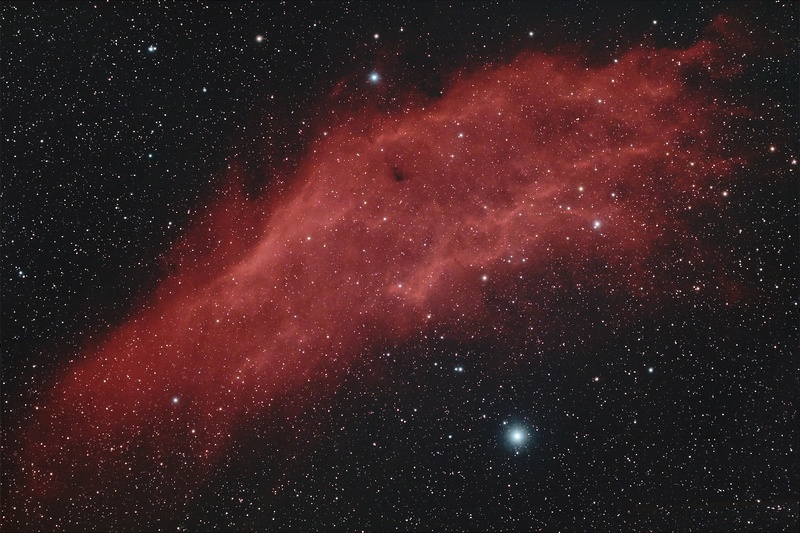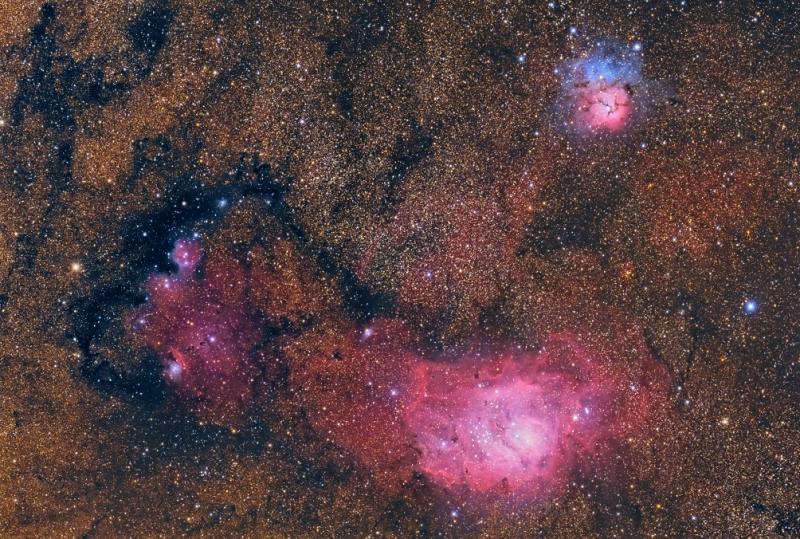I find this part of the sky very beautiful, but it is also maddening, because it is somewhat hard to figure out what is going on!
NGC 6559. Photo: Roberto Sartori.
1) NGC 6559 itself. I'm not sure whether it is only the red ridge of ionized gas that is called NGC 6559, or if the blue reflection nebula surrounding two stars "inside" this star forming region is also a part of NGC 6559, or if the entire cluster inside this star forming region is also a part of NGC 6559.
2) HD 165921, spectral class O7V, the most important ionizing star of this region.
3) Two stars of which the most important one is HD 166107, a blue star of spectral class B2V that creates the blue reflection nebula that surrounds the two stars.
4) A fascinating small cluster of stars that appear to have recently broken through their dusty birth cocoon. The blue stars inside are of spectral classes B0.5V, B1V and (indeterminate) OB. In short, these stars are just hot enough to ionize an emission nebula, but the nebula is going to be a rather dull shade of purple rather than bright red, which would be the case if the stars were hotter. Even the inner part of the nebula is still dusty, and the stars' blue light is reflected in the dust grains to create a combined emission/reflection nebula. Note that the edges of the "hill of dust", called Barnard 91, to the lower right of the cluster, are being brightly lit up in blue by the light from the stars. Note, too, that the dust is being "eaten away" by the ultraviolet light and the wind from the stars. Note the blue streamers of gas and dust that emanate from the blue edge of Barnard 91 as they are evaporating and then are streaming leftward, across the face of the cluster.
5) This is a star of spectral class B3. It has created a blue reflection nebula around itself, but it is quite incapable of ionizing a red emission nebula.
Let's look a bit more at NGC 6559:
There are similarities between the California Nebula and NGC 6559, because both these nebulas are red ridges of ionized gas. But the California nebula is being ionized by
Xi Per, which is much hotter than the stars inside the little cluster "below" NGC 6559, and Xi Per may be a runaway star, too, so that it is "pushing" the interstellar medium in front of it like a snowplow.
The red ridge of NGC 6559 is probably caused by forces acting on it "from two directions" - from the young stars in the dusty nebula "below" it, obviously, but also from the powerful O-type star HD 165921 "above" it, which fascinatingly enough seems to be "connected" to NGC 6559 by a winding dust lane. NGC 6559 is being squeezed between two opposing forces, and it being assaulted by ultraviolet photons from two opposite directions!
As for HD 165921 appears to be a quite young star, because it is surrounded by a fascinating mess of rather dark dust lanes.
IC 1274 near NGC 6559. Photo: R. Jay GaBany.
Can't keep R. Jay GaBany's picture of IC 1274 away from you, as it demonstrates so dramatically how gas and dust is being evaporated away from dust structure Barnard 91 and is streaming away across the face of the underlying cluster.
I also wanted to show you how the NGC 6559 region is connected to the mighty Lagoon Nebula by a many light year-long thick dust lane that encircles the entire NHGC 6559 region and then reaches towards the Lagoon.
Ann
 NGC 6559: East of the Lagoon
NGC 6559: East of the Lagoon



